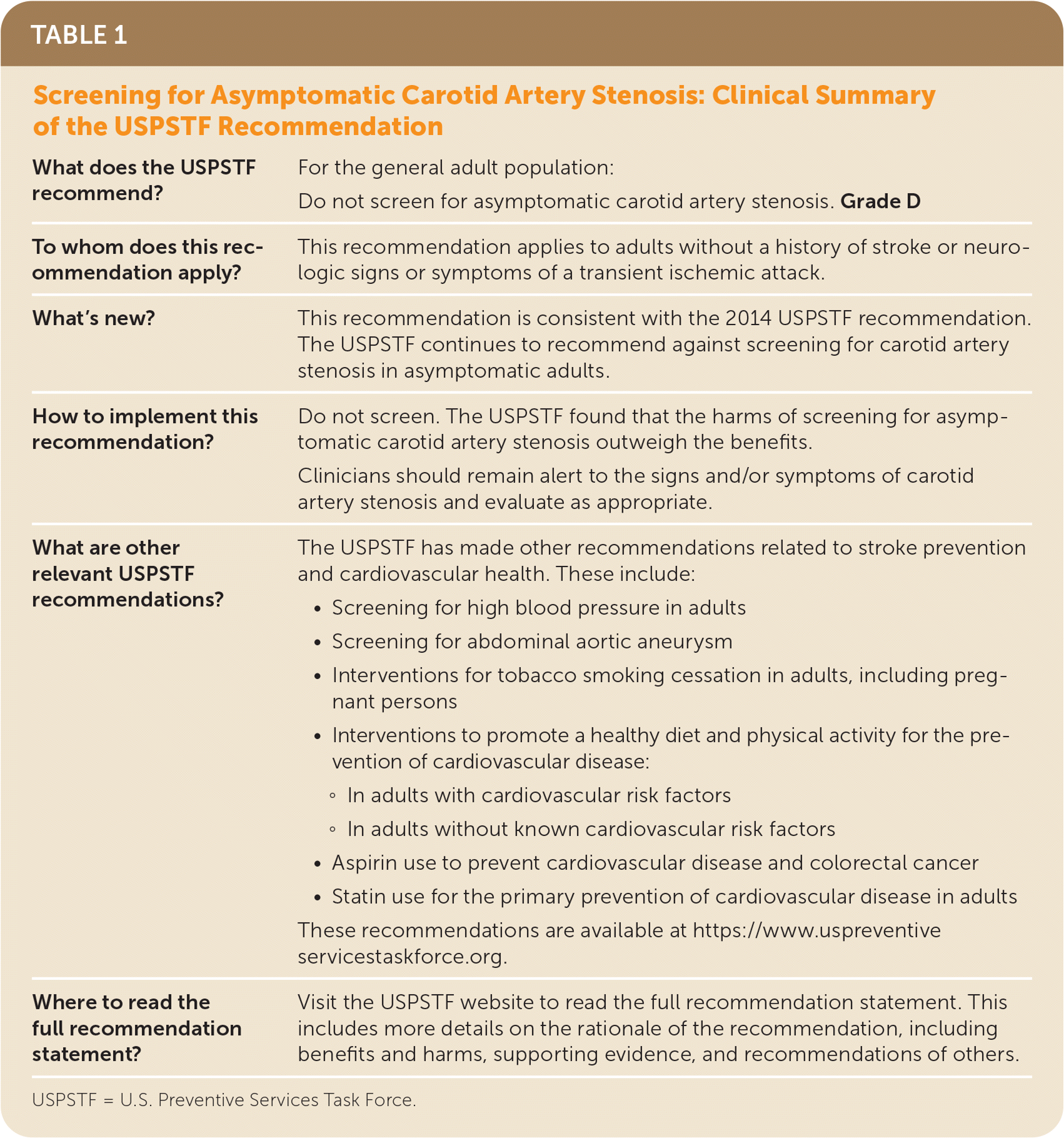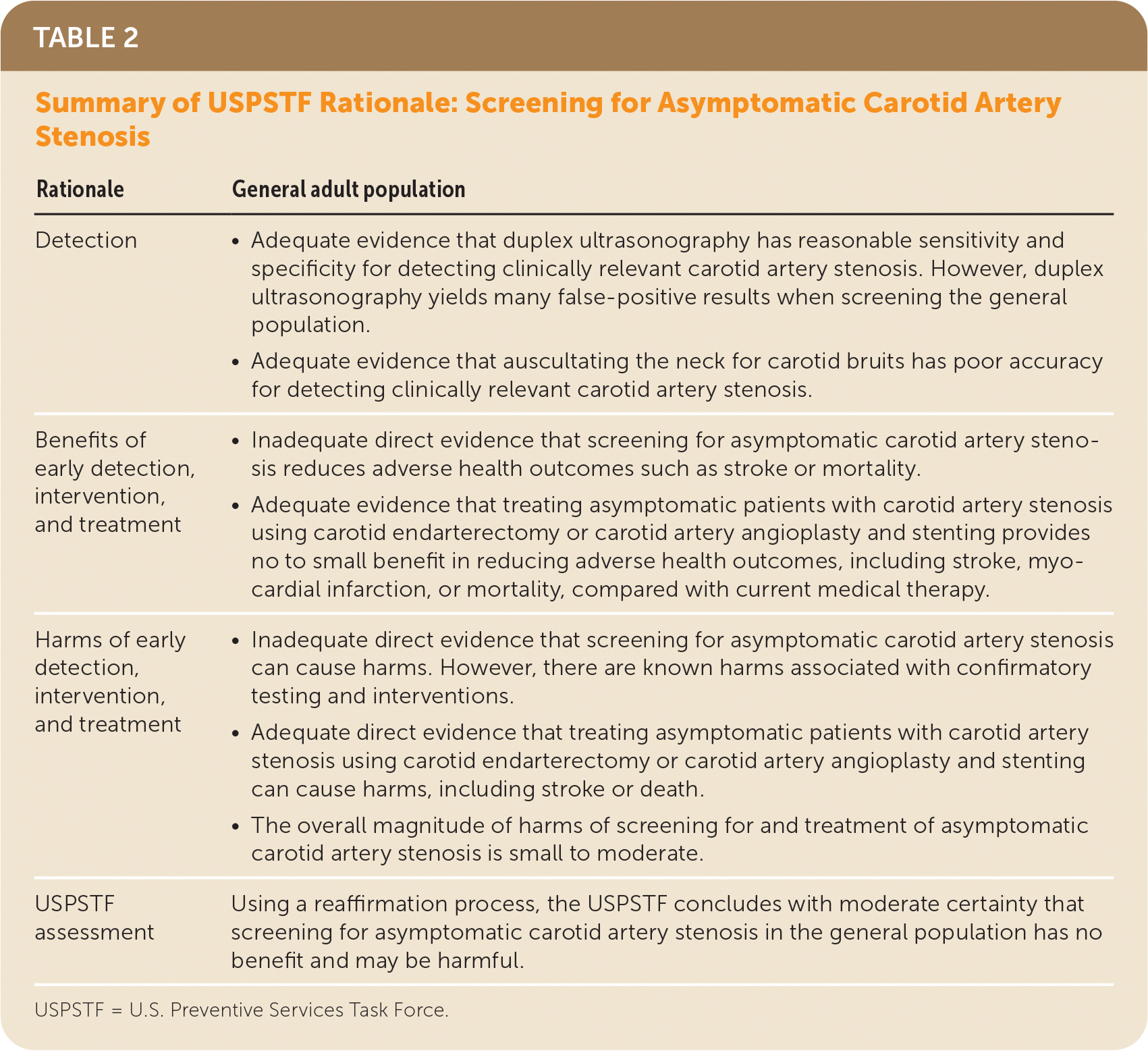
Am Fam Physician. 2021;103(10):614-617
Related Putting Prevention into Practice: Screening for Asymptomatic Carotid Artery Stenosis
As published by the USPSTF.
Summary of Recommendation and Evidence
The USPSTF recommends against screening for asymptomatic carotid artery stenosis in the general adult population (Table 1). D recommendation.

| What does the USPSTF recommend? | For the general adult population: Do not screen for asymptomatic carotid artery stenosis. Grade D |
| To whom does this recommendation apply? | This recommendation applies to adults without a history of stroke or neurologic signs or symptoms of a transient ischemic attack. |
| What's new? | This recommendation is consistent with the 2014 USPSTF recommendation. The USPSTF continues to recommend against screening for carotid artery stenosis in asymptomatic adults. |
| How to implement this recommendation? | Do not screen. The USPSTF found that the harms of screening for asymptomatic carotid artery stenosis outweigh the benefits. Clinicians should remain alert to the signs and/or symptoms of carotid artery stenosis and evaluate as appropriate. |
| What are other relevant USPSTF recommendations? | The USPSTF has made other recommendations related to stroke prevention and cardiovascular health. These include:
These recommendations are available at https://www.uspreventiveservicestaskforce.org. |
| Where to read the full recommendation statement? | Visit the USPSTF website to read the full recommendation statement. This includes more details on the rationale of the recommendation, including benefits and harms, supporting evidence, and recommendations of others. |
See the Practice Considerations section for a description of adults at increased risk.
Importance
Carotid artery stenosis is atherosclerotic disease that affects extracranial carotid arteries. Asymptomatic carotid artery stenosis refers to stenosis in persons without a history of ischemic stroke, transient ischemic attack, or other neurologic symptoms referable to the carotid arteries. The prevalence of asymptomatic carotid artery stenosis is low in the general population but increases with age.1 Although asymptomatic carotid artery stenosis is a risk factor for stroke and a marker for increased risk for myocardial infarction, it causes a relatively small proportion of strokes.2 Stroke is a leading cause of death and disability in the United States.3
USPSTF Assessment of Magnitude of Net Benefit
REAFFIRMATION
In 2014, the USPSTF reviewed the evidence for screening for carotid artery stenosis and issued a D recommendation.4 The USPSTF has decided to use a reaffirmation deliberation process to update this recommendation.5 The USPSTF uses the reaffirmation process for well-established, evidence-based standards of practice in current primary care practice for which only a very high level of evidence would justify a change in the grade of the recommendation.5 In its deliberation of the evidence, the USPSTF considers whether the new evidence is of sufficient strength and quality to change its previous conclusions about the evidence.
Using a reaffirmation process, the USPSTF concludes with moderate certainty that the harms of screening for asymptomatic carotid artery stenosis outweigh the benefits.

| Rationale | General adult population |
|---|---|
| Detection |
|
| Benefits of early detection, intervention, and treatment |
|
| Harms of early detection, intervention, and treatment |
|
| USPSTF assessment | Using a reaffirmation process, the USPSTF concludes with moderate certainty that screening for asymptomatic carotid artery stenosis in the general population has no benefit and may be harmful. |
Practice Considerations
PATIENT POPULATION UNDER CONSIDERATION
This recommendation applies to adults without a history of transient ischemic attack, stroke, or other neurologic signs or symptoms referable to the carotid arteries.
ASSESSMENT OF RISK
Although screening for asymptomatic carotid artery stenosis is not recommended for the general adult population, several factors increase risk for carotid artery stenosis, including older age, male sex, hypertension, smoking, hypercholesterolemia, diabetes, and heart disease.6 However, there are no externally validated, reliable methods to determine who is at increased risk for carotid artery stenosis or who is at increased risk of stroke when carotid artery stenosis is present.7–9
SCREENING TESTS
Several modalities are proposed for screening for carotid artery stenosis, including carotid duplex ultrasonography, magnetic resonance angiography, and computed tomography angiography. Auscultation for carotid bruits has been found to have poor accuracy for detecting carotid stenosis or stroke and is not considered a reasonable screening approach.7 The USPSTF does not recommend screening adults without a history of transient ischemic attack, stroke, or other neurologic signs or symptoms referable to the carotid arteries.
TREATMENT
Medical and surgical options are available for treatment of carotid artery stenosis. In general, treatment of asymptomatic carotid artery stenosis is directed at systemic atherosclerotic disease and often includes statins, antiplatelet medications, management of hypertension and diabetes, and lifestyle modification interventions. Surgical procedures designed to improve carotid artery blood flow include carotid endarterectomy, carotid artery angioplasty and stenting, or transartery revascularization. Medical therapy can be used alone or with revascularization procedures.7 For patients with asymptomatic disease, the harms of surgical interventions compared with appropriate medical therapy appear to outweigh the benefits.
OTHER RELATED USPSTF RECOMMENDATIONS
The USPSTF has issued other recommendation statements related to stroke prevention and cardiovascular health. These include:
Screening for high blood pressure in adults10
Screening for abdominal aortic aneurysm11
Interventions for tobacco smoking cessation in adults, including pregnant persons12
Interventions to promote a healthy diet and physical activity for the prevention of cardiovascular disease:
In adults with cardiovascular risk factors13
In adults without known cardiovascular risk factors14
Aspirin use to prevent cardiovascular disease and colorectal cancer15
Statin use for the primary prevention of cardiovascular disease in adults16
This recommendation statement was first published in JAMA. 2021;325(5):476–481.
The “Updates of Previous Recommendations," "Supporting Evidence,” “Research Needs and Gaps,” and “Recommendations of Others” sections of this recommendation statement are available at https://www.uspreventiveservicestaskforce.org/uspstf/recommendation/carotid-artery-stenosis-screening.
This summary is one in a series excerpted from the Recommendation Statements released by the USPSTF. These statements address preventive health services for use in primary care clinical settings, including screening tests, counseling, and preventive medications.
The complete version of this statement, including supporting scientific evidence, evidence tables, grading system, members of the USPSTF at the time this recommendation was finalized, and references, is available on the USPSTF website at https://www.uspreventiveservicestaskforce.org/.
The USPSTF recommendations are independent of the U.S. government. They do not represent the views of the Agency for Healthcare Research and Quality, the U.S. Department of Health and Human Services, or the U.S. Public Health Service.
